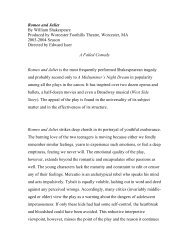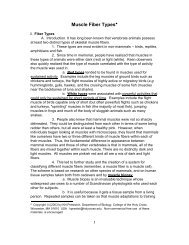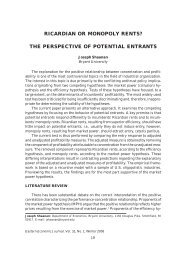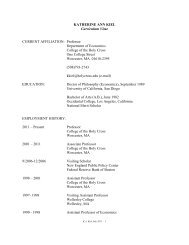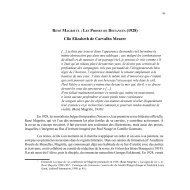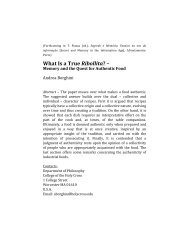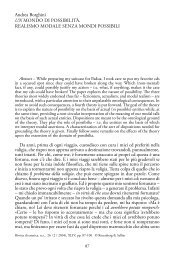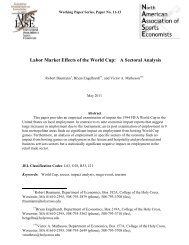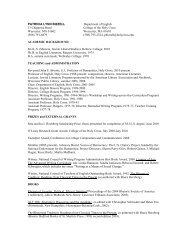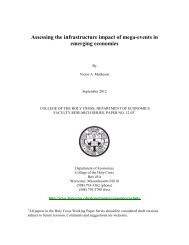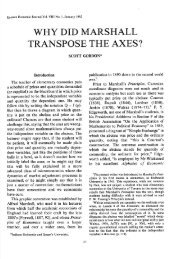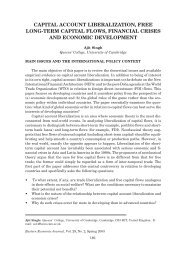club objectives and ticket pricing in professional team sports
club objectives and ticket pricing in professional team sports
club objectives and ticket pricing in professional team sports
You also want an ePaper? Increase the reach of your titles
YUMPU automatically turns print PDFs into web optimized ePapers that Google loves.
554<br />
EASTERN ECONOMIC JOURNAL<br />
Turn<strong>in</strong>g to the comparative statics analysis, <strong>in</strong> order to derive the impact of an<br />
exogenous change <strong>in</strong> player salary on <strong>ticket</strong> price <strong>and</strong> talent dem<strong>and</strong>, <strong>and</strong> differentiat<strong>in</strong>g<br />
the first-order conditions <strong>in</strong> equations (4) <strong>and</strong> (5) with respect to the unit cost of<br />
talent w, one can f<strong>in</strong>d that<br />
(12)<br />
(13)<br />
∂<br />
∂ =−<br />
p π pl<br />
<<br />
w ππ − π 2 0<br />
ll pp pl<br />
∂<br />
∂ =<br />
l π pp<br />
<<br />
w ππ − π 2 0<br />
ll pp pl<br />
Contrary to what is generally claimed by many American <strong>club</strong> owners, who argue<br />
that player salaries have to be kept low <strong>in</strong> order to keep the <strong>ticket</strong> prices low, a higher<br />
salary level turns out to reduce the optimal <strong>ticket</strong> price <strong>in</strong> the profit maximiz<strong>in</strong>g<br />
scenario. The reason is that a higher salary reduces the dem<strong>and</strong> for talent, which<br />
causes the dem<strong>and</strong> curve for <strong>ticket</strong>s to shift to the left so that the profit (or revenue)<br />
maximiz<strong>in</strong>g <strong>ticket</strong> price will be set at a lower level. In Figure 1, a higher salary level<br />
will shift the locus π l = 0 down so that the optimal <strong>ticket</strong> price <strong>and</strong> talent dem<strong>and</strong> will<br />
be lower. Apply<strong>in</strong>g the envelope theorem to profit function (3), it follows that higher<br />
player salaries reduce owner profits. This is probably the real reason why owners are<br />
talk<strong>in</strong>g player salaries down.<br />
The comparative statics analysis also confirms that large market <strong>club</strong>s hire more<br />
talents <strong>and</strong> charge higher <strong>ticket</strong> prices than small market <strong>club</strong>s. In Figure 1, a larger<br />
value of m will shift the locus π l = 0 to the left <strong>and</strong> the locus π p = 0 to the right so<br />
that, at the new po<strong>in</strong>t of <strong>in</strong>tersection, both the <strong>ticket</strong> price <strong>and</strong> the dem<strong>and</strong> for talent<br />
are higher.<br />
Turn<strong>in</strong>g to the w<strong>in</strong> maximiz<strong>in</strong>g scenario, a <strong>club</strong>’s objective is to maximize the<br />
season w<strong>in</strong>n<strong>in</strong>g percentage, which can only be done by maximiz<strong>in</strong>g the number of<br />
play<strong>in</strong>g talents. It is not necessary to stick to the breakeven constra<strong>in</strong>t, because the<br />
constant capital cost (c 0 ) can also <strong>in</strong>clude a certa<strong>in</strong> amount of positive or negative<br />
profits. Because the capital stock is constant <strong>in</strong> the short run, a constant amount of<br />
profits also means a fixed profit rate. So, we no longer assume that <strong>club</strong>s are profit<br />
maximizers, but that they can be profitable, break even or make a loss. In this approach<br />
we follow the model <strong>in</strong>troduced by Kesenne [1996, 2000], realiz<strong>in</strong>g that add<strong>in</strong>g<br />
this constra<strong>in</strong>t is a simplification because it does not allow the (utility maximiz<strong>in</strong>g)<br />
owner preferences to enter the analysis. Our aim is only to f<strong>in</strong>d out how the results<br />
change if two decision variables are <strong>in</strong>troduced <strong>in</strong> this model.<br />
If <strong>club</strong>s maximize the number of play<strong>in</strong>g talents l under the follow<strong>in</strong>g restriction<br />
0<br />
(14) ( p+ q) A−wl− c = 0



